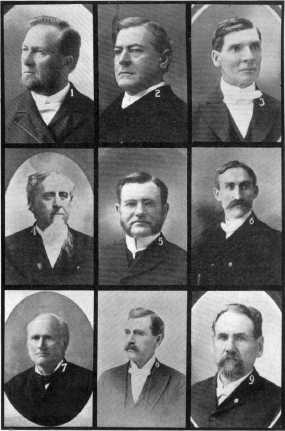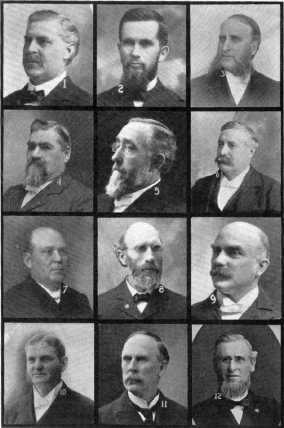
CHAPTER XXVIII.
FOURTH PERIOD. (1880-1904.)
CONCLUSION.
THE
following bishops have presided at the Nebraska Conferences during
these fifty years: Morris, Simpson, Ames, Baker, Scott, Kingsley,
Thomson, Janes, Clark. Andrews, Bowman, Gilbert Haven, Foster,
Harris, Warren, Merrill, Wiley, Mallalieu, Fowler, Hurst, Voss,
Vincent, Goodsell, Walden, Newman, McCabe, Ninde, FitzGerald.
Of these twenty-eight bishops there are none
whose presence has not been influential for good. The very
presence of these chief pastors has been a benediction to all, and
especially to the younger members. These bishops have all been men
of good ability, and by their addresses and counsel during
Conference sessions, and the sermon on the Sabbath have made a
deep impression for good. Under no other system do the people and
preachers have the privilege of meeting and hearing from so many
of the chief men of the Church. Some of these sermons have been
the event of a lifetime with some of these preachers, as was that
of Bishop Foster at Falls City in 1876, which, after more than a
quarter of a century, is still fresh in the memory of those of us
who were permitted to hear it.
It may be said that these have all been men of
great
549
|
550 |
HISTORY OF NEBRASKA METHODISM. |
personal power and influence. But when you add to this
the vast official power with which the Church has clothed them, by
which they have the entire legal authority to determine the
appointment of every member of Conference, and also those on
trial, you have a factor that can not but be a power for good if
wisely and conscientiously used. Though our bishops may be
fallible and make mistakes, they have no motive for using this
vast power otherwise than in the interest of the Church.
At the four Nebraska Conferences of 1903 Bishop
Andrews, in the exercise of this power, assigned over 350 men to
different places and positions. If we take 150, less than half
this number. as the average number thus appointed from year to
year by the several presiding bishops, we have a total for the
fifty years of 7,500 appointments made by these bishops, chiefly
to pastorates and presiding elderships.
How much of the success of these fifty years has
been due to the wisdom and spirit in which these appointments have
been made may not be in our power to determine. That much is due
to this cause can not be doubted.
Besides these regular services at the
Conferences many of these bishops have aided on special occasions
in dedicating churches, delivering lectures, and other like
services. Two of them, Newman and McCabe, have been resident
bishops in Omaha, and have been specially helpful to the Churches
in that city and others throughout the State. As elsewhere noted,
Bishop Fowler may be said to be the father of our present
educational institution and the splendid service of Bishop McCabe
in helping to rescue that institution from the burden of debt will
not soon be forgotten.

MINISTERIAL DELEGATES TO GENERAL CONFERENCE.
1. WILLIAM
GORST. 2. W. B.
ALEXANDER 3. JOHN GALLAGHER.
4. P. C. JOHNSON. 5. C. A.
MASTIN. 6. W. E.
HARDAWAY.
7. WM. M. WORLEY. 8.
L. F. BRITT. 9. J. W.
STEWART.
551
|
552 |
HISTORY OF NEBRASKA METHODISM. |
Nebraska Methodism will bear the test
of comparison with other sister Churches. For this purpose I have
chosen the United States census religious statistics for 1870 and
1890. I have chosen these two dates because this feature of the
census does not appear before 1870, and those for 1900 are not out
yet. But as these cover the period of greatest growth in
population and consequent need, and during the eighties, the
greatest opportunities for church-building and expansion in all
directions, the comparison for that period will serve as a sample
of what has been done during all periods of Nebraska history.
The three items with which the census deals are
the number of organizations, the number of churches, and the
number of sittings these churches afford. Here Methodism is at a
disadvantage in 1870 by reason of the fact that under our economy
in our circuit system there are sometimes from two to five
separate organizations combined in one and so reported, while with
all the other denominations included in this comparison each such
organization is counted separately and so reported. So we should
remember in reading these figures that to get at the real facts we
should multiply the number of our organizations in 1870 by three.
But in 1890 the number 649 indicates that the census report
conforms to the facts. The above caution, of course, does not
apply to churches and sittings.
|
Churches. |
Date. |
Organizations. |
Edifices. |
Sittings. |
|
Methodists |
1870 |
50 |
36 |
10,150 |
|
Baptists |
1870 |
26 |
15 |
5,400 |
|
Presbyterians |
1870 |
24 |
9 |
3,125 |
|
Congregationalists |
1870 |
10 |
7 |
2,050 |
|
Lutherans |
1870 |
14 |
7 |
2,000 |
|
HISTORY OF NEBRASKA METHODISM. |
553 |
|
Churches. |
Date. |
Organizations. |
Edifices. |
Sittings. |
|
Episcopalians, |
1870 |
15 |
12 |
3,500 |
|
Catholics, |
1870 |
17 |
11 |
2,935 |
|
Methodists, |
1890 |
649 |
461 |
112,000 |
|
Baptists, |
1890 |
230 |
164 |
36,500 |
|
Presbyterians, |
1890 |
228 |
155 |
34,900 |
|
Congregationalists, |
1890 |
172 |
144 |
32,000 |
|
Lutherans, |
1890 |
387 |
253 |
49,900 |
|
Catholics, |
1890 |
213 |
179 |
38,390 |
This story of the fifty years of
Methodism will property close with a brief summary of results and
a glance at some of the causes of the success that is written on
every page.
These results may be divided into two classes,
the visible and the invisible. (Note that all previous statistics,
except German and Swedish, and those which follow, relate to our
English-speaking work alone, the German-Swedish occurring
elsewhere.)
During the fifty years Nebraska Methodism has
received from the Missionary Society to aid in supporting the men
in the field the sum of $461,832. This was often the chief
reliance of the frontier preacher, the one thing on which he could
bank. Not infrequently it amounted to much more than the people
were able to pay, and its absence would have meant suffering if
not starvation.
To support her ministry during the entire fifty
years Nebraska Methodism has promised, including salaries and
house rent, a total of $4,817,420, and has paid a total of
$4,367,283. This leaves her still in debt, according to ordinary
standards, to her ministers that have actually done her service
these fifty years, to the amount of $450,137. It will be easy to
reckon how far this would go if paid
|
554 |
HISTORY OF NEBRASKA METHODISM. |
now to producing the $100,000 Conference Claimants' Fund
proposed during this, her jubilee year. There should, however, be
deducted from this balance still due the amount given to
Conference claimants in fifty years, being $34,460. That still
leaves us short in our account with the old veterans to the amount
of $415,677.
It is true that much of this deficit accrued
during the first twenty-five years, before financial conditions
became favorable and the Church became thoroughly organized so as
to handle her financial affairs efficiently.
Of the $461,832 received from the Missionary
Society in fifty years, $256,025 have been returned by collections
during that time. This leaves us $205,807 behind in our account
with the Missionary Society.
To the several other benevolent interests we
have contributed during the half-century, or during the time they
have been in existence, as follows: For Church Extension, $42,204;
Freedmen's Aid, $40,189; Tract, $5,619; Sunday-school Union,
$6,434; Woman's Foreign Missionary Society, $77,332; Woman's Home
Missionary Society, $52,752; Education, public collection,
$134,230; Children's-day Fund, $12,955; Bible Society, $9,869;
Methodist. Hospital, $10,786.
The total contributed to all the benevolences,
not including Conference Claimants, General Conference expenses,
Episcopal Fund, or "other" collections, $631,163.
While doing this and paying preachers we have
built 574 churches, at a cost of $1,592,955, and 321 parsonages,
at a cost of $330,525, besides the second and third churches and
parsonages that have been erected in many places.
While in the statistical tables the Conference
Claim-

MINISTERIAL DELEGATES TO GENERAL CONFERENCE.
1. F. M. SISSON. 2. GEO. I. WRIGHT. 3. J. W. SHENK. 4. P. H. EIGHMY.
5. JAMES LEONARD. 6. D. K. TINDALL. 7. JESSE W. JENNINGS.
8. C. A. HALE. 9. ALFRED HODGETTS. 10. C. C. LASBY.
11. A. R. JULIAN. 12. A. C. CROSTHWAITE.
555